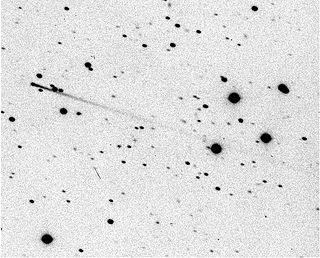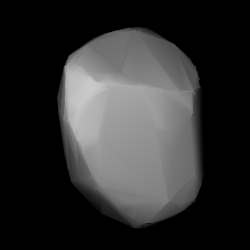
4015 Wilson–Harrington is an active asteroid known both as comet 107P/Wilson–Harrington and as asteroid 4015 Wilson–Harrington. It passed 0.4 AU (60 million km) from Earth on 20 July 2022 and then passed perihelion on 24 August 2022. It seldom gets brighter than apparent magnitude 16. It will return to perihelion on 25 November 2026.

Comet Elst–Pizarro is a body that displays characteristics of both asteroids and comets, and is the prototype of active asteroids. Its orbit keeps it within the asteroid belt, yet it displayed a dust tail like a comet while near perihelion in 1996, 2001, and 2007.

Dike is a quite large and dark main-belt asteroid. Dike was discovered by Alphonse Borrelly on May 28, 1868. It was his first asteroid discovery. This object is named after Dike, the Greek goddess of moral justice. Among the first hundred numbered minor planets, 99 Dike was considered anomalously faint for over a century. However, this was later found to be untrue.

Phaedra is a sizable, rocky main belt asteroid that was discovered by Canadian-American astronomer James Craig Watson on September 2, 1877, and named after Phaedra, the tragic lovelorn queen in Greek mythology.

Weringia is a typical main-belt asteroid. It was discovered by Johann Palisa on 19 July 1882, and was named after Währing, part of Vienna, the city where the asteroid was discovered. Photometric observations during 2008 showed a rotation period of 11.1496 ± 0.0009 hours and a brightness variation of 0.20 ± 0.02 in magnitude.

Adrastea is a main belt asteroid. It was discovered by Johann Palisa on 18 August 1884 in Vienna, and was named after the Greek nymph Adrasteia. This asteroid is orbiting the Sun at a distance of 2.97 AU with a period of 5.11 years and an eccentricity (ovalness) of 0.23. The orbital plane is tilted at an angle of 6.17° to the plane of the ecliptic.

Regina is a typical, although fairly large, Main belt asteroid. It was discovered by Auguste Charlois on 3 August 1889 in Nice, France. The asteroid is a suspected interloper in the Eucharis asteroid family.

Gudrun is a main-belt asteroid.

May is a large Main belt asteroid. It was discovered by Auguste Charlois on 28 November 1892 in Nice, and was named for the German author Karl May. This asteroid is orbiting the Sun at a distance of 2.97 AU with a period of 5.12 years and an eccentricity (ovalness) of 0.067. The orbital plane is inclined at an angle of 9.7° to the plane of the ecliptic. During its orbit, this asteroid has made close approaches to the dwarf planet Ceres. For example, in September 1984 the two were separated by 6.3 Gm (0.042 AU).

402 Chloë is a large main-belt asteroid. It was discovered by French astronomer Auguste Charlois on 21 March 1895 from Nice. This asteroid is orbiting the Sun at a distance of 2.56 AU with a period of 4.09 years and an eccentricity of 0.11. The orbital plane is inclined at an angle of 11.8° to the plane of the ecliptic.
Natalie is a typical Main belt asteroid.
Stereoskopia is a large, outer main-belt asteroid orbiting the Sun. It was discovered on 28 May 1905 from Heidelberg by German astronomer Paul Götz. The discovery was made from photographic plates with the use of a stereo-comparator that had been provided by Carl Pulfrich, a German physicist at the Carl Zeiss Company. The asteroid name is a reference to this device.
Cheruskia is a minor planet, specifically an asteroid orbiting in the asteroid belt that was discovered by German astronomer Paul Götz on 26 July 1905 from Heidelberg.
618 Elfriede is a minor planet orbiting the Sun. On July 24, 2013, it occulted the magnitude 12.8 star 2UCAC 23949304, over parts of Mexico and southwestern United States.
60558 Echeclus is a centaur, approximately 84 kilometers (52 miles) in diameter, located in the outer Solar System. It was discovered by Spacewatch in 2000 and initially classified as a minor planet with provisional designation 2000 EC98 (also written 2000 EC98). Research in 2001 by Rousselot and Petit at the Besançon observatory in France indicated that it was not a comet, but in December 2005 a cometary coma was detected. In early 2006 the Committee on Small Bodies Nomenclature (CSBN) gave it the cometary designation 174P/Echeclus. It last came to perihelion in April 2015, and was expected to reach about apparent magnitude 16.7 near opposition in September 2015.
118401 LINEAR, provisional designation 1999 RE70, is an asteroid and main-belt comet (176P/LINEAR) that was discovered by the Lincoln Near-Earth Asteroid Research (LINEAR) 1-metre telescopes in Socorro, New Mexico on September 7, 1999. (118401) LINEAR was discovered to be cometary on November 26, 2005, by Henry H. Hsieh and David C. Jewitt as part of the Hawaii Trails project using the Gemini North 8-m telescope on Mauna Kea and was confirmed by the University of Hawaii's 2.2-m (88-in) telescope on December 24–27, 2005, and Gemini on December 29, 2005. Observations using the Spitzer Space Telescope have resulted in an estimate of 4.0±0.4 km for the diameter of (118401) LINEAR.
12238 Actor is a Jupiter trojan from the Greek camp, approximately 30 kilometers in diameter. It was discovered on 17 December 1987, by astronomers Eric Elst and Guido Pizarro at the La Silla Observatory in northern Chile. The dark Jovian asteroid has a rotation period of 7.3 hours. It was named after Actor, father of the heroes Eurytus and Cteatus from Greek mythology.
3936 Elst, provisional designation 2321 T-3, is a stony Vestian asteroid from the inner regions of the asteroid belt, approximately 5 kilometers in diameter. The asteroid was discovered on 16 October 1977, by Dutch astronomer couple Ingrid and Cornelis van Houten at Leiden, on photographic plates taken by Dutch–American astronomer Tom Gehrels at Palomar Observatory in California, United States. It was named after Belgian astronomer Eric W. Elst.
'4501 Eurypylos is a Jupiter trojan from the Greek camp, approximately 46 kilometers in diameter. It was discovered on 4 February 1989 by Belgian astronomer Eric Elst at ESO's La Silla Observatory in Chile. The dark Jovian asteroid has a short rotation period of 6.1 hours. It was named after the Thessalian king Eurypylus from Greek mythology.

2017 XO2, also written 2017 XO2, is a sub-kilometer asteroid and near-Earth object of the Apollo group approximately 110 meters (360 feet) in diameter. The asteroid was discovered by Pan-STARRS in December 2017, after it already had approached Earth at 0.051 AU (7,600,000 km) or 20 lunar distances (LD) on 6 November 2017. On 26 April 2057, it will pass Earth at a similar distance of 21 LD again.











